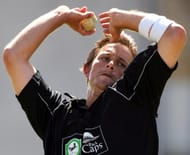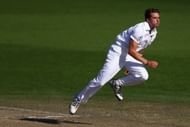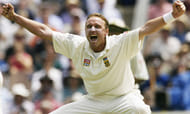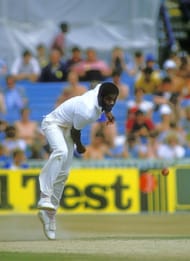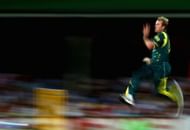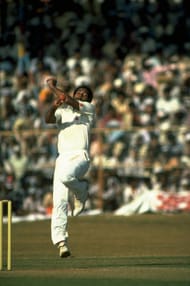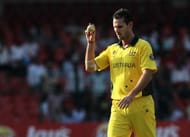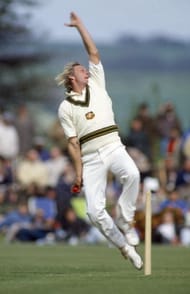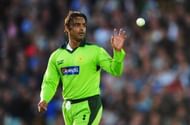Bowling at whirlwind pace is sometimes enough to frighten a poor batsman out of his wits. The bowler begins his run to the crease slowly, giving absolutely no indication of the thunderbolt he’s about to unleash, or the bruising that the willow-wielder at the other end would be subjected to in mere moments.
He slowly increases his speed, accelerating hard with each step, his flowing mane billowing out behind him, a feral snarl on his face. By this time, the batsman has started quivering in his boots – from nervousness or fear, no one knows. The bowler thunders past the umpire, leaps high, and fires the ball towards the hapless figure opposite, who loses his head for a fraction of a second and makes an error in judgment that results in the loss of his wicket.
It was the infamous Bodyline series that brought the havoc caused by fast bowling to international attention – though I am somewhat doubtful about the actual origins. Over the years, the art of menacing batsmen around the world flourished with the emergence of the West Indian attack in the seventies and eighties, the advent of India’s Kapil Dev (though he wasn’t as quick as a Roberts or a Garner) and the fiery Dennis Lillee a bit earlier.
Here is a list of the ten fastest bowlers in modern history:
10. Fidel Edwards (West Indies)
The Barbados tearaway was drafted into the West Indies national squad after playing just one game – he impressed the legendary Brian Lara at the nets so much so that he was included for the Jamaica Test against Sri Lanka. His raw pace flummoxed the Lankans so completely that he ended up with a five-wicket haul on debut.
With a round-arm action reminiscent of former Australian pacer Jeff Thomson, and blessed with immense speed, Edwards was destined for a long spell in the national side. However, persistent back injuries have seen him in and out of the side. He recovered sufficiently to ply his trade for the Deccan Chargers in the IPL, where he troubled the batsmen with his pace and bounce.
Having returned from surgeries numerous times, Edwards is looking to hit the 160 km/hr mark as he sets himself the goal of becoming the world’s best fast bowler. His current speed is somewhere above the 145 km/hr, and if he stays injury-free, we could soon see the return of the West Indian pace battery that dominated cricket in the late eighties.
9. Shane Bond (New Zealand)
Described as New Zealand’s best fast bowler since Richard Hadlee, the enigmatic Shane Bond is the rare blend of speed and accuracy that is missing from some of the current crop of pacers. At his best, he was capable of regularly bowling at speeds in excess of 145 km/hr; yet, he was also hampered by the bane of sportsmen – recurrent injuries, particularly of the back and the foot, forced him to call time on his international career in 2010.
Bond’s best ODI performances include a match-winning haul of 6/19 against India in 2005, a brilliant hat-trick against Australia in 2007 and another haul of 6/23 against the same opponents in the 2003 World Cup; the Kangaroos were his favourite ‘prey’, as was evident by his solid performances against them. He also turned out for the Kolkata Knight Riders in the IPL, having received amnesty from the NZ Cricket Board after signing up for the now-defunct ICL.
Currently, Bond, a former police officer, is the bowling coach of the NZ national cricket team, and has served in this capacity for the Central Districts Stags in the HRV Cup as well as the 2010 Champions League.
8. Dale Steyn (South Africa)
The 30-year-old powerfully-built pacer from Transvaal has been one of the greatest strike bowlers to have played the game. Like Bond, he also clocks speeds of around 145-150 km/hr, his fastest being 156.2 km/hr, recorded at IPL 2010. In international cricket, Steyn’s quickest delivery is 155.7 km/hr, which he sent down against New Zealand.
One of the most impressive characteristics about Steyn is his ability to maintain control over his pace and the high rate of accuracy with which he bowls. At the kind of speeds he generates, his mastery over both line and length makes him even more lethal. In the limited-overs format, however, he has proven to be expensive and a bit wayward at times, but he has always struck back with a vengeance, using a mixture of slower balls and short-pitched stuff to keep batsmen hopping about the crease.
Definitely a terrific talent unearthed by South Africa!
7. Allan Donald (South Africa)
He wasn’t known as ‘White Lightning’ for nothing. With a fearsome scowl and a circular white area of zinc cream across his cheeks & nose, Allan Donald was easily one of the best world-class bowlers in the nineties, and arguably, the only one in the South African squad of those days to deserve that epithet.
In both Tests and ODIs, Donald bore the burden of leading the Proteas’ pace attack until the emergence of Shaun Pollock, with whom he formed a lethal combination. In typical fast-bowler fashion, he was involved in a heated confrontation with the unflappable Rahul Dravid during India’s 1996-97 tour. His duel with former England captain Mike Atherton at the 1998 Trent Bridge Test is also legendary, as he proceeded to bowl a fast, fearsome spell at the batsman, who remained resolute and immovable.
Besides his exploits in international cricket, Donald also enjoyed a successful spell with Warwickshire, and is currently the coach of the Sahara Pune Warriors in the IPL. He may have hung up his boots, but his legacy continues with the likes of Dale Steyn, Morne Morkel and Vernon Philander taking over the mantle admirably.
6. Michael Holding (West Indies)
One of the fastest bowlers to have played the game, Michael Holding was fortunate enough to play in an era when the West Indies were kings of world cricket. He formed a vital part of the famed pace battery consisting of Andy Roberts, Joel Garner, Malcolm Marshall, Sylvester Clarke, Colin Croft and Wayne Daniel.
In a rarity for a quick bowler, Holding had a quiet, smooth run-up to the bowling crease; hence his nickname ‘Whispering Death’. His bowling was very smooth and fast, and he used the advantage of height to generate a lot of bounce and zip off the pitch. He was one of the outstanding performers on the tour to England in 1976, as his team swept Tony Greig’s men 3-0.
Holding forged a strong partnership with Andy Roberts, with the pair taking 216 Test wickets between them – and in 1981, bowled ‘the greatest over in Test history’ to Geoff Boycott, troubling the thorny Yorkshireman with the first five deliveries, each speedier than the last. The final ball saw Boycott being bowled, delighting the Bridgetown crowd.
Holding is now a noted cricket commentator and has also been an ICC official for a short period of time since his retirement. He is also a vocal critic of Twenty20, contending that it isn’t good for the game of cricket.
5. Brett Lee (Australia)
For most of the early 21st century, the former Australian spearhead was second only to Pakistani speed demon Shoaib Akhtar in terms of sheer pace ; the two were notable for being the fastest bowlers in contemporary cricket. He regularly touched speeds of 150 km/hr, but the strain of bowling at those rates consistently caused him to suffer stress fractures of the back – the kind of injuries that had almost halted former Australian great Dennis Lillee’s career in 1973.
He altered his bowling strategy and re-emerged as a speedster who would still touch 150 km/hr, but relied more on variations in pace – including a mix of slower balls, bouncers and full-length deliveries. Officially, he has come close to the 100 mph barrier once during a game against New Zealand in 2005; although he had broken the mark with a 161.8 km/hr delivery against the West Indies in 2001-02 (unrecognized by the ICC).
Injuries, a suspect bowling action and personal turmoil forced the jovial pacer to announce his retirement from international cricket in 2012. He continues to ply his trade as player and bowling mentor for the Kolkata Knight Riders in the IPL, and has also served as a cricket commentator for Channel Nine.
4. Andy Roberts (West Indies)
Part of the famed West Indian pace quartet from the mid-seventies to the early eighties (along with Holding, Garner and Colin Croft, later Malcolm Marshall), the giant fast bowler from Antigua was deceptive in addition to being very quick. Roberts bowled in tandem with Holding in 33 Test matches, and the Antiguan had a devastating effect on opposition batsmen around the globe in both formats of the game.
He used to bowl two bouncers – the first one slow in pace, lulling the batsman into a false sense of security, and then came the second one; similar to the first but bowled at extreme speeds. The batsman would try to repeat the earlier scoring shot, but be shocked at the extra bounce and eventually lose his wicket.
Since his retirement from international cricket (after having won the first two World Cups in 1975 and 1979), Roberts has chiefly served as a cricket administrator, and even mentored Indian left-arm seamer Irfan Pathan in 2006. He was also the first Antiguan to play Test cricket, and was followed by many other luminaries including Viv Richards, Richie Richardson and Curtly Ambrose.
3. Shaun Tait (Australia)
Nicknamed ‘The Wild Thing’, the South Australian quick has a slinging action which reminds one of former great Jeff Thomson. He is also considered as one of the fastest bowlers in the world, often delivering the ball at speeds upwards of 150 km/hr.
In a T20 international game against Pakistan in 2010, Tait sent down a delivery clocked at 160.7 km/hr. Despite his speed, the slinger is very erratic and inclined to spray the ball around; as a result, he usually proves to be expensive, especially in ODI cricket. Kiwi skipper Daniel Vettori and then-coach John Bracewell publicly expressed their doubts over the legality of Tait’s bowling action in 2007 – something that did not go down well with the tearaway.
He retired from ODIs after the 2011 World Cup to focus solely on Twenty20 cricket – he had helped the side win its fourth world championship title in 2007 with a series of strong performances. Injuries also have forced him to take an indefinite break from first-class cricket. His 160.7 km/hr delivery is the third fastest behind Shoaib Akhtar and Brett Lee.
2. Jeff Thomson (Australia)
No list of fast bowlers is complete without the Australian legend Jeff Thomson. Known affectionately as “Thommo”, he was among the fastest bowlers of his generation, and formed a powerful combination with another tearaway quick Dennis Lillee.
Before the 1974-75 Ashes series commenced, he made a controversial remark about how much he enjoyed hurting the batsman rather than getting him out. He possessed an unconventionally shorter run-up to the crease, generating his pace through a slinging action – a remnant from his former javelin throwing days. Since he relied more on bounce than movement, the hard Australian tracks were more suited to his style than the slower English wickets.
Thomson ended up taking 33 wickets in his debut Ashes series – and his partnership with Lillee during that season was fearsome. While competing in a fast-bowling contest in 1978, Jeff clocked 147.9 km/h – faster than Holding or Imran Khan. He was also timed at 160.45 km/h using high-speed cameras, and touched 160.57 km/hr through conventional radar. With that kind of speed, a batsman would have had to play his shot more than a quarter of a second before Thomson actually delivered the ball.
As was common with pace bowlers, Thomson also suffered from a spate of injuries, and was less effective in his later career. He retired in 1985, and has served as a commentator.
1. Shoaib Akhtar (Pakistan)
Brash, speedy and controversial, the Rawalpindi Express is arguably the fastest bowler of modern times. He has bowled at speeds of 161.3 km/hr, 160 km/hr three times and hovered near the same mark another two times – all in 2002.
At Eden Gardens during the Asian Test championship in 1999, a debuting Akhtar ripped out Dravid and Tendulkar off successive deliveries; it was the latter’s first ever duck in Test cricket. His impressive bowling performances saw him make the cut for the 2003 World Cup, but he had a mediocre tournament, especially in the game against India where he conceded 72 runs off his ten overs and was taken to the cleaners in his first over by both Tendulkar and Sehwag.
In and out of the team on several occasions for commitment and drug-related issues, Akhtar re-emerged in 2005 as a premier fast bowler for his side when he routed England during the Test series held in Pakistan. He had added the slower delivery to his arsenal, and his effective use of such balls made him unplayable for the English batsmen.
His struggles with injuries have been well-documented in the press, raising questions about his fitness and longevity. Disciplinary issues, a charismatic personality and a chaotic public life have all contributed to his apparent decline as a bowler, and he announced his retirement from international cricket at the end of the 2011 World Cup.
Brand-new app in a brand-new avatar! Download CricRocket for fast cricket scores, rocket flicks, super notifications and much more! 🚀☄️
